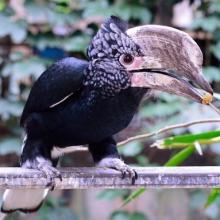Bycanistes brevis

Conservation Status:
Least Concern
Range:
South-central to south-eastern parts of Africa
Habitat:
Coastal, mountain and evergreen forests
The Silvery-cheeked Hornbill is predominantly black with white patches and a silvery-grey head and neck. The species possesses a large beak with a casque on top, which is more prominent in males. A casque refers to the hollow chamber located on the upper part of the beak. The purpose of the casque remains unknown, though theories suggest it may amplify the hornbill's call or aid in identifying individuals within a flock.
During the day, Silvery-cheeked Hornbills typically spend time with a mate or a small group of hornbills, reconvening as a flock at night. Their diet primarily consists of whole fruits, enabling the dispersal of seeds. Additionally, they consume berries, nuts, insects, eggs, and small animals.
The female hornbill lays her eggs in a hollow tree, rock, or soil. A typical clutch comprises 1 to 3 eggs. Subsequently, the female remains within the hollow while her mate seals the entrance. The male provides food by passing it through a small hole as the female incubates the eggs, a process that lasts approximately 30 to 40 days. Mother and chicks remain sealed inside for about a month, after which the mother breaks free to assist the male in locating food for the growing chicks. The chicks start to fledge at around 80 days old.
